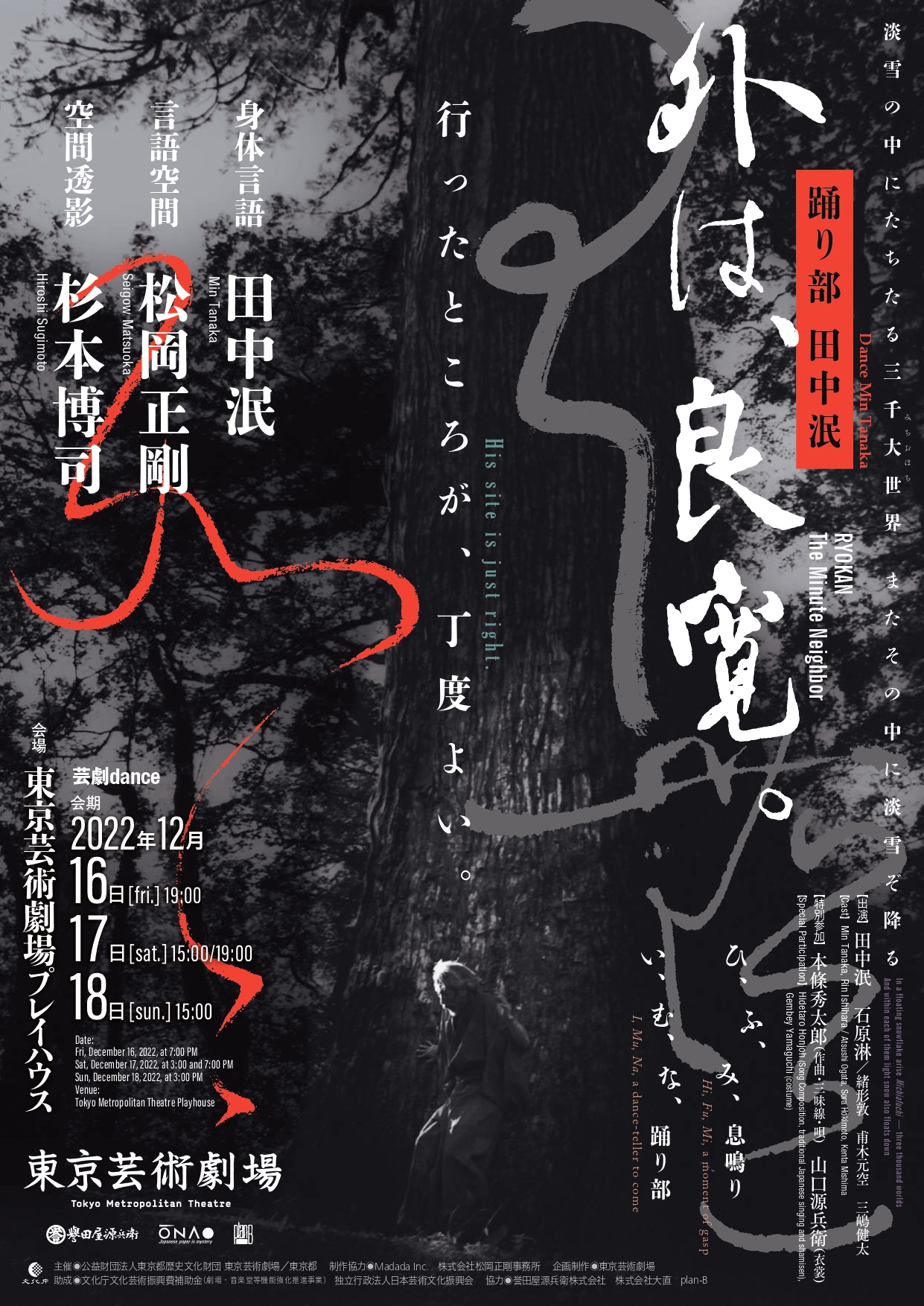“Ryokan dances in the light snow falling in three thousand worlds,” wrote editorial engineer Seigow Matsuoka in his deeply imaginative treatise on Ryokan, entitled Soto wa Ryokan. Ryokan was a Zen Buddhist monk, poet, and calligrapher of the Edo period (1603–1868) who reflected on impermanence and held a transcendental view of life. Inspired by this masterpiece, dancer Min Tanaka presented his interpretation of Ryokan as the “dance-teller” of RYOKAN, The Minute Neighbor, which was performed at the Tokyo Metropolitan Theatre from December 16 to 18, 2022.
![]()
![]()
事務局からのお知らせ
Experiencing the Spiritual World of Ryokan in RYOKAN, The Minute Neighbor (Starring Dance-teller Min Tanaka) <Tokyo Metropolitan Theatre>
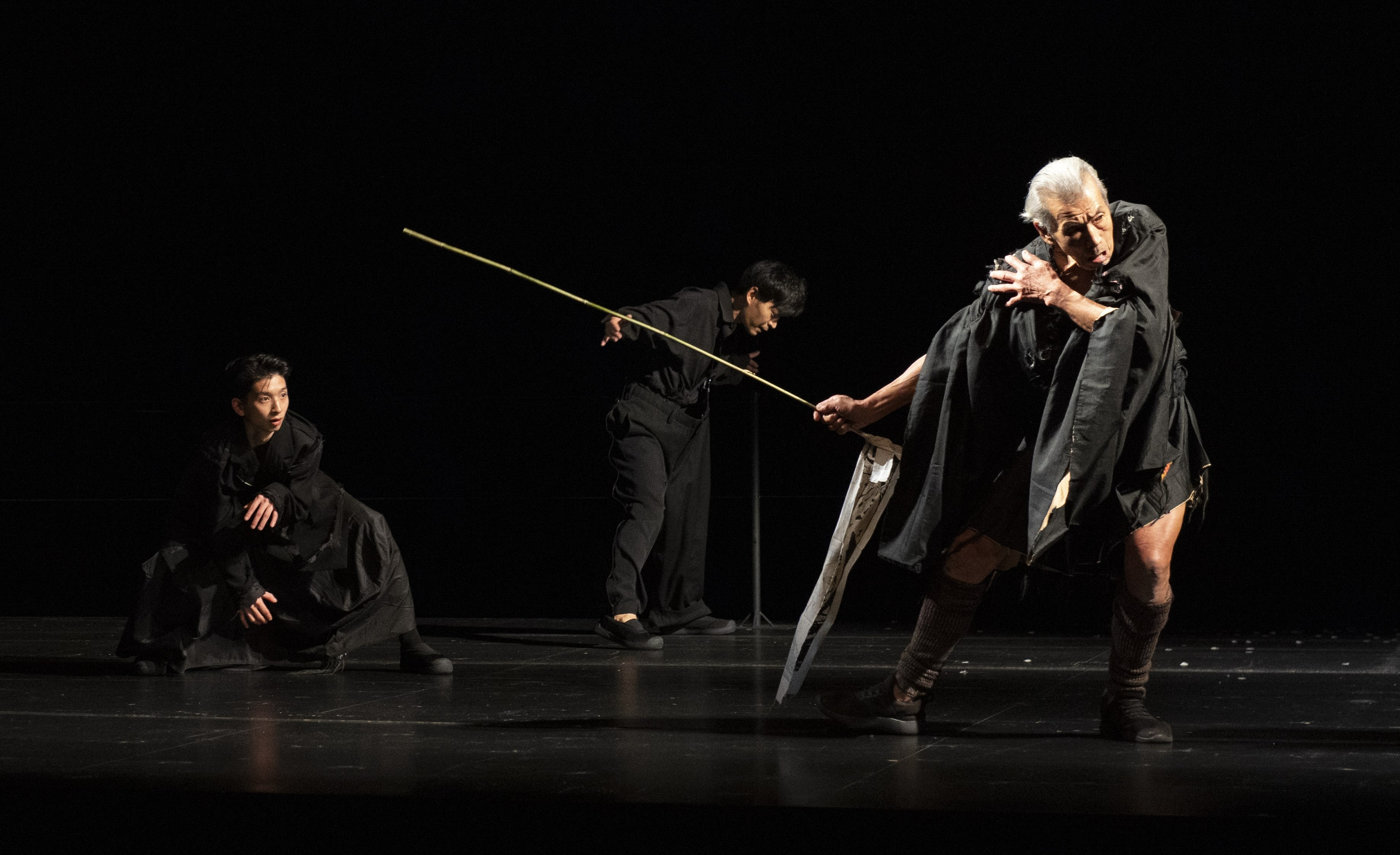
Contemporary artist Hiroshi Sugimoto also took part in the production. Three creators, each a master of their own craft, collaborated on this groundbreaking performance that brilliantly captured the spiritual world of Ryokan. The following is a brief report on this production.
Reporting and text: Ayako Takahashi Translation: Jena Hayama
Three giants of the art world combine their knowledge and aesthetics
RYOKAN, The Minute Neighbor (starring theatrical dance-teller Min Tanaka) was performed at the Tokyo Metropolitan Theatre at the end of 2022. The production brought the knowledge and aesthetics of three giants to the stage, featuring Min Tanaka’s body language, Seigow Matsuoka’s “language space,” and Hiroshi Sugimoto’s “space trance-jection.”
The production was inspired by Seigow Matsuoka’s book, Soto wa Ryokan, in which Matsuoka reveals his own worldview through the lens of Ryokan. According to the book’s afterword and the theatrical pamphlet, the idea for the performance came about when Min Tanaka read the book over again and contacted Matsuoka, saying, “I want to dance this story as ‘one of its dance-tellers.’” The resulting performance featured the work of three people in their 70s alongside that of shamisen player, composer, and singer Hidetaro Honjoh and obi (kimono sash) master Gembey Yamaguchi. Together, they brought to life the spiritual world of Ryokan, who lived to the age of 74.
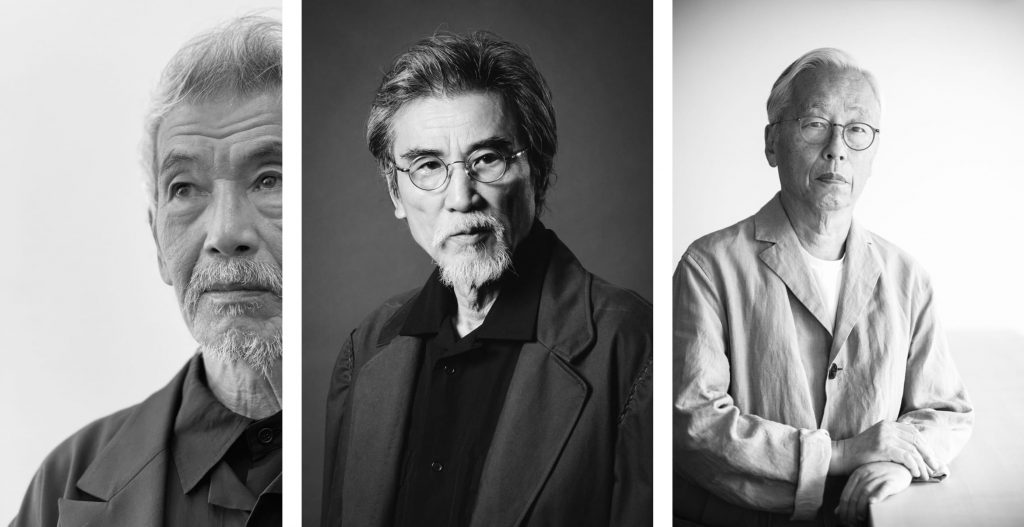
Embodying “Ryokan’s universe”
The performance opens with the appearance of three men in black (Atsushi Ogata, Sora Hokimoto, and Kenta Mishima) in the audience, calling out: “Hey, where’d he go?” “As if I know!” They drop a woman in a red kimono (Rin Ishihara), whom they were carrying, into the aisle and leave.
There’s the sound of birds. The woman slowly makes her way to the stage and lies down on a platform on stage left. At the back of the stage is a screen. As the men in black move around below the screen, the words of Ryokan’s waka poem, “Aki no hi ni” (On an autumn day), emerge on the backdrop.
“Whereamong ears of pampas grass glistering in the harvest sun / we could all gather and dance on this person’s back” The word “dance,” written in Ryokan’s distinctive calligraphy, overlaps with subsequent song lyrics—“shall we dance, shall we dance”—and link Ryokan with the “dance-teller,” Min Tanaka.

Eventually, Ryokan’s calligraphy disappears, and a photograph from Hiroshi Sugimoto’s Seascapes series emerges on-screen. That scenery, combined with what Matsuoka calls “Ryokan’s northern-ness,” appears on this stage to be both a gleaming northern sea and a desolate snowfield. At the back of the stage, a single rope drops straight down into the deep abyss. From time to time, the rope is shaken from below. Is it the underground or the sea that lies beneath it?
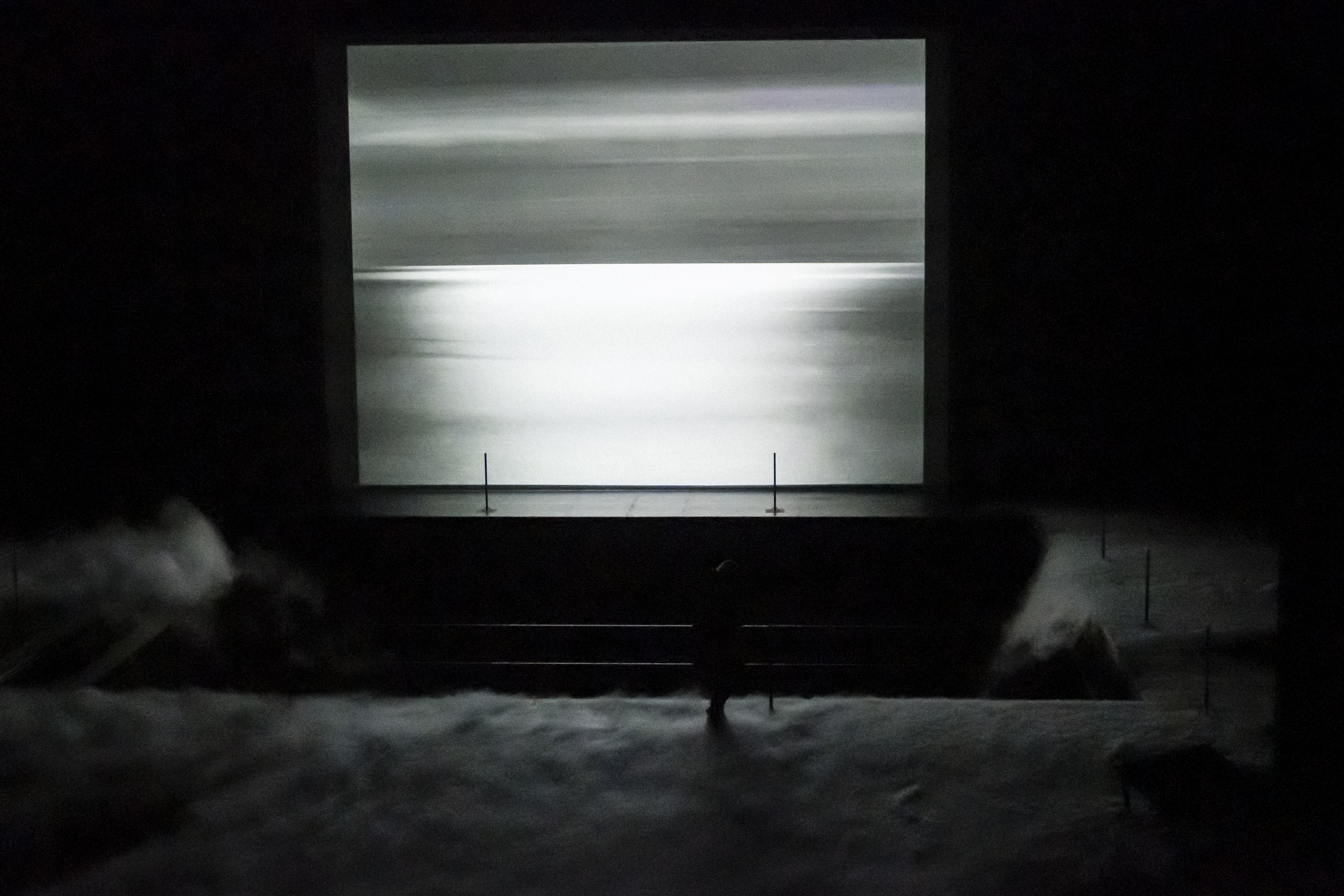

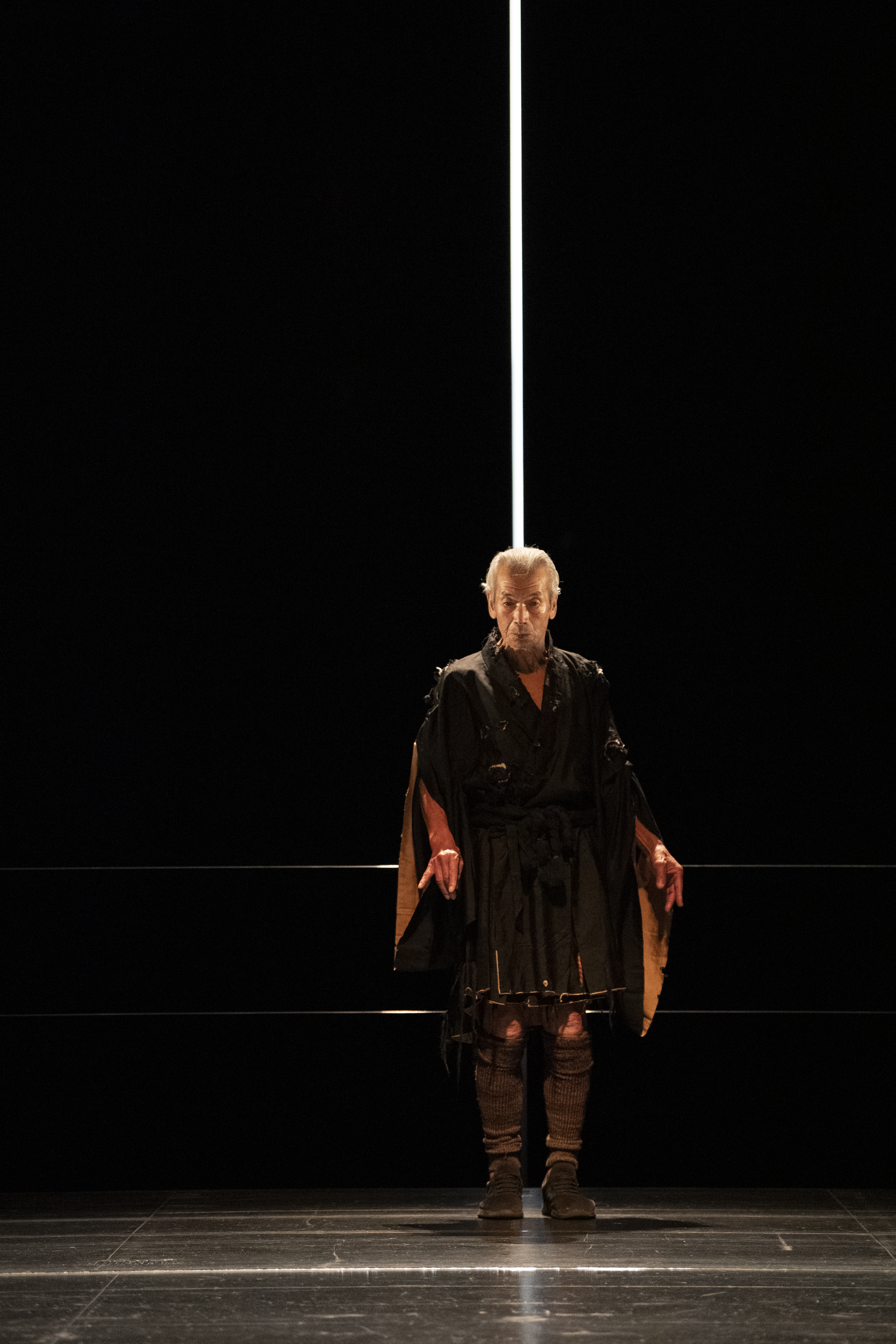
Soon after, the lonesome sound of a shamisen can be heard as Ryokan (portrayed by Tanaka) enters the stage, illuminated by a man holding a light. The woman and Ryokan face each other for a moment, but quickly move apart. The relationship between the woman and Ryokan is portrayed intermittently thereafter. At one point, their relationship is enigmatic; at another, playful, as the pair happily jumps rope with a rope made of obi-himo cords. The woman’s identity is never made clear, but two women, Ikyo-ni and Teishin-ni (both nuns), are known to have been important figures in Ryokan’s life. Teishin-ni, in particular, although four decades younger than Ryokan, admired him greatly and even exchanged waka poems with him containing the character for “love.” She was also the person who cared for him in his final days. The woman in the red kimono could be a symbol of the woman who lit a light in Ryokan’s heart.

Somewhere along the way, several cube-shaped frames emerge from the abyss and take the shape of a house. At first, Ryokan wanders around outside, but then he enters the house with the woman. The image of falling snow is projected on the screen. Along with music by Hidetaro Honjoh, a waka poem by Teishin-ni is recited: “Kites are with kites / sparrows sparrows, herons herons / a crow with a crow—what is odd about it?” This poem reveals the close relationship between Ryokan and Teishin-ni, who called each other crow. In another part of the performance, a poem akin to the hifumi-uta, a song sung using an old method of counting in Japanese, is recited. Hi-fu-mi (meaning one, two, three) was one of Ryokan’s favorite lyrics, and he incorporated it into many poems and waka poems, one of which he composed in response to the first waka poem that Teishin-ni sent to him.
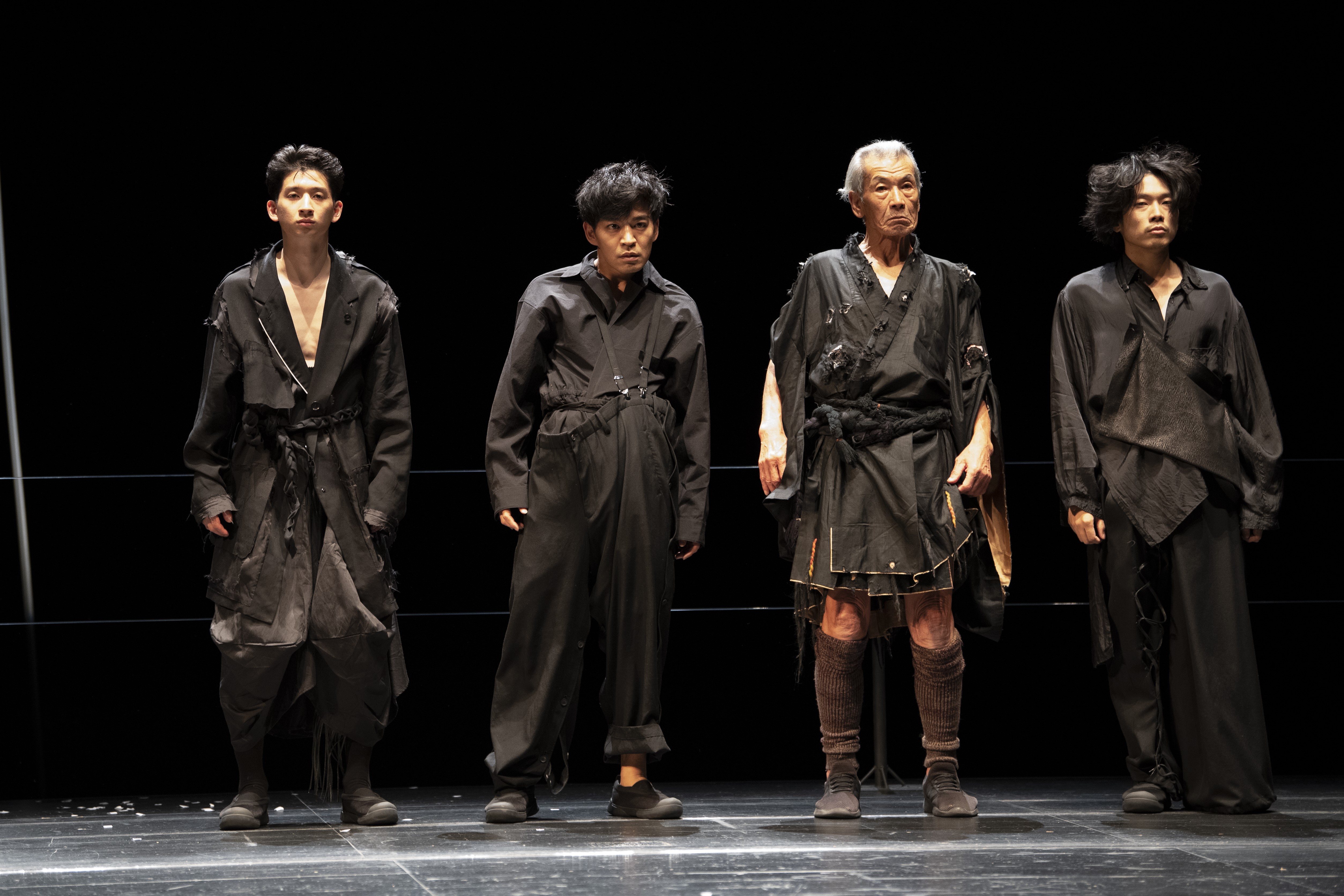
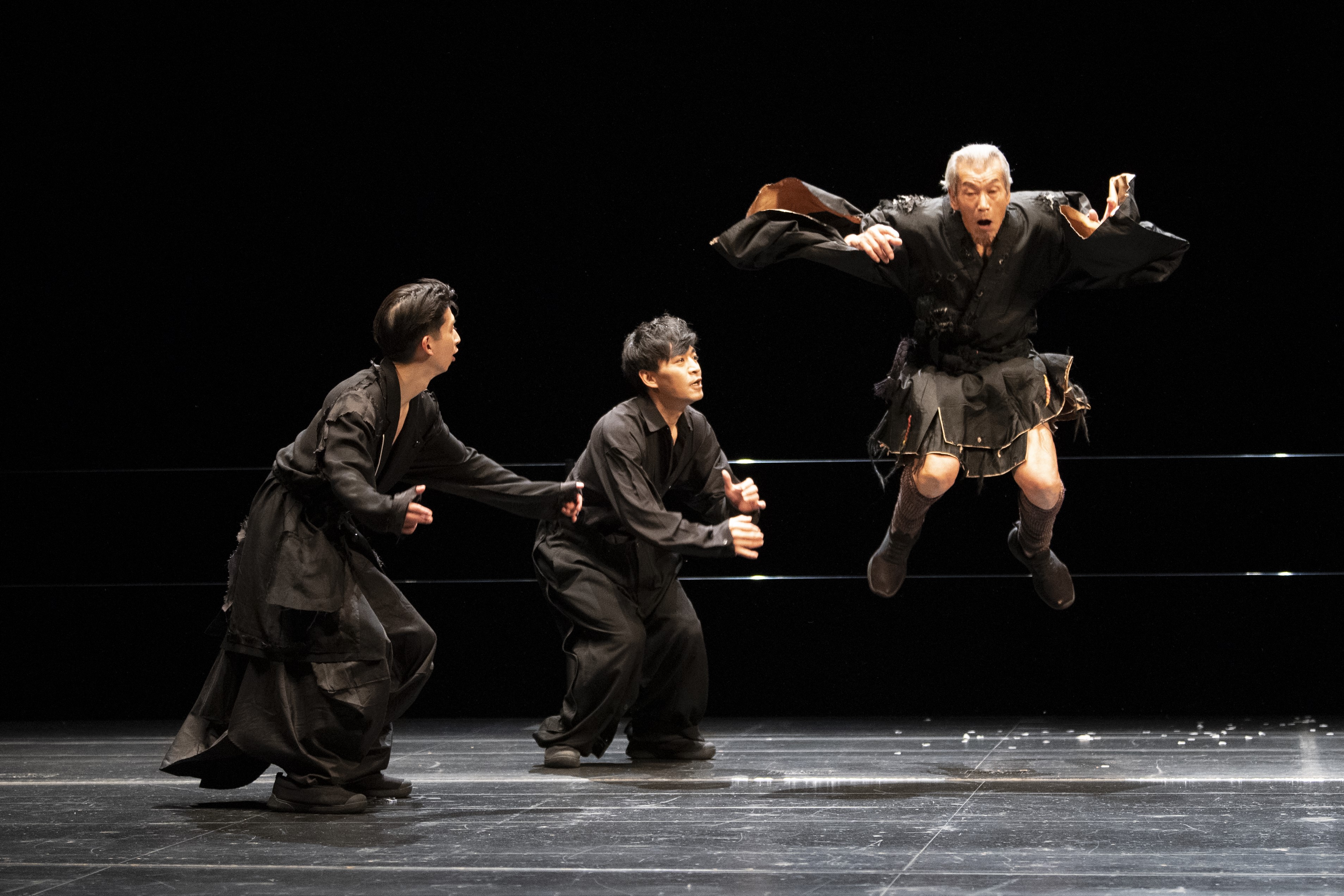
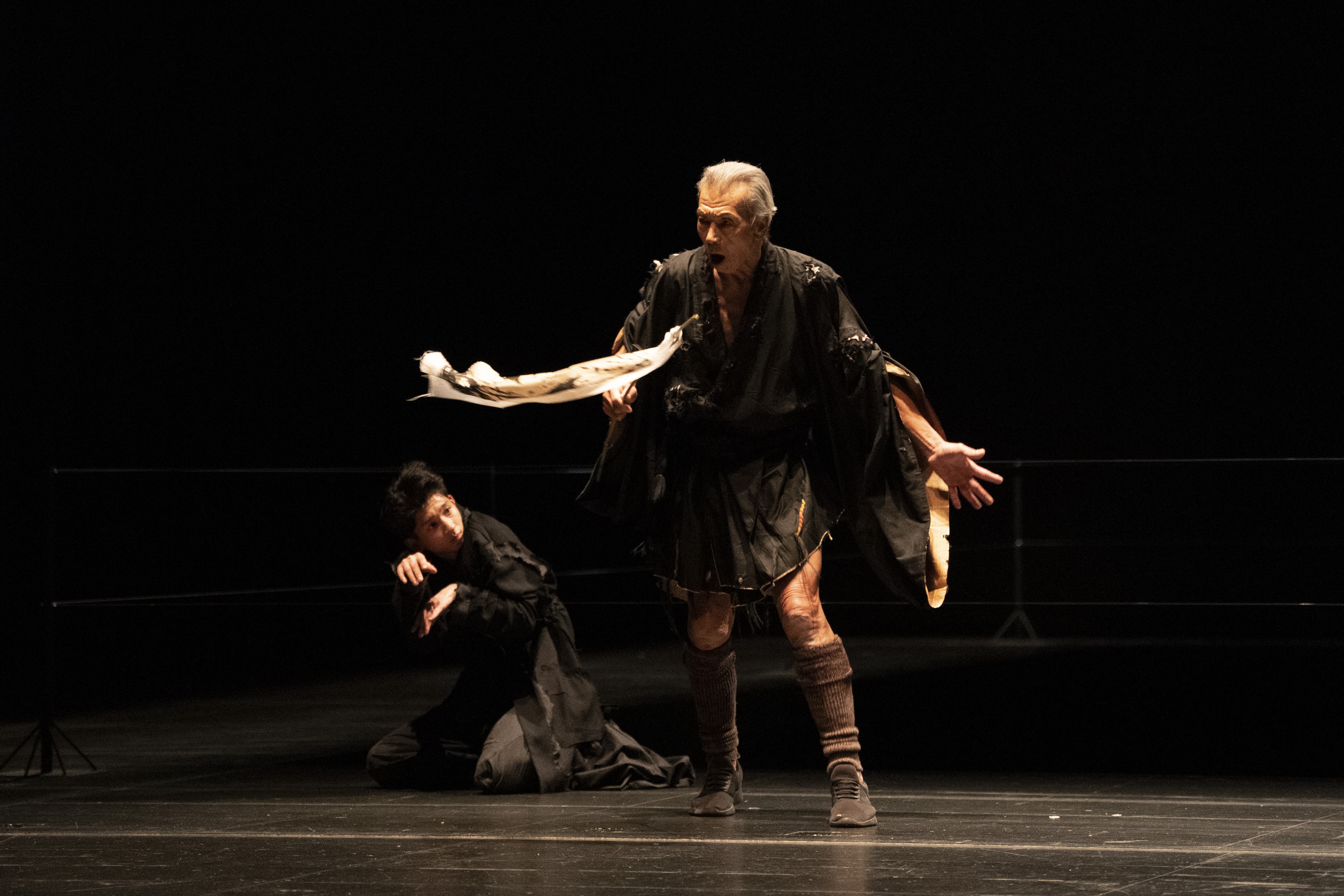
While the woman appears before Ryokan in an unchanging form throughout the production, the three men give off different impressions each time, seeming from time to time to be children, or animals. Tanaka (as Ryokan) displays various expressions, frolicking around with them, dropping to his knees with disappointment, pretending to bounce a ball, and writing i–ro–ha–ni–ho–he–to in hiragana (the Japanese alphabet) with a banner that is handed to him.
Here we catch glimpses of Ryokan’s old age and loneliness, the “fragility” and “childlike old soul” that Matsuoka used in his analysis of Ryokan. At times, it overwhelms the viewer with an almost maniacal intensity. Although this may fascinate the casual observer, it is by no means easy to comprehend. However, Matsuoka’s text, which Tanaka reads aloud at intervals, helps us to understand. He describes Ryokan’s lifestyle, calligraphy, women, and his “northern-ness,” which goes hand-in-hand with being a person from the “north.”
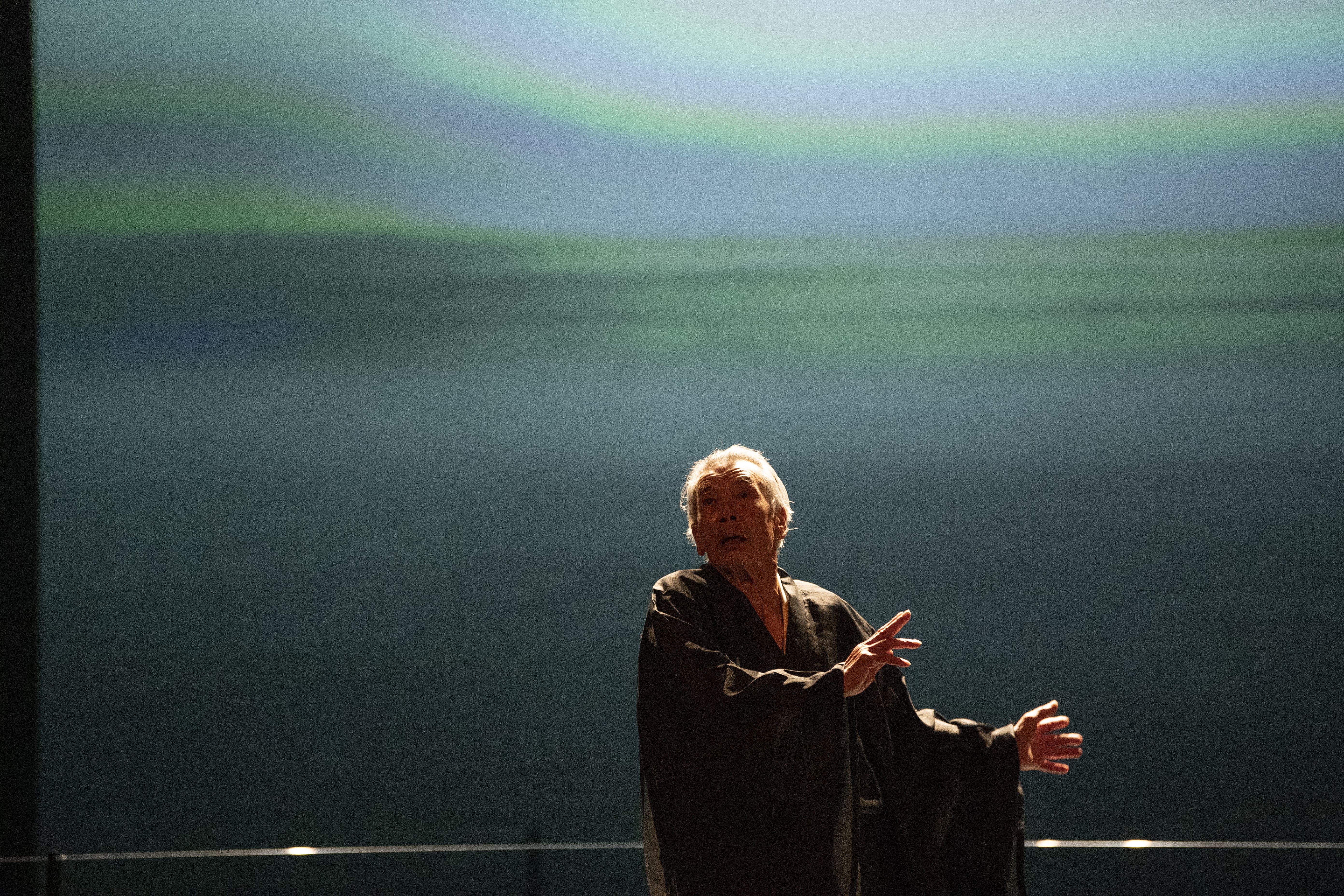
The story then turns to the “True North,” that is, Ryokan’s death. Tanaka dances to the enka song Suki ni Natta Hito (The Person I Came to Love). His movements are light and evoke a sense of affection and sadness at loving life while facing death. Do the lyrics, which are about love, express Teishin-ni’s feelings? Or are those the feelings of both Teishin-ni and Ryokan? When the song ends, Tanaka sits down, wearing nothing but a single white robe.
Recited together with the music is the waka poem, “In a floating snowflake arise Michiafuchi—three thousand worlds / and within each of them light snow also floats down.” This poem was composed by Ryokan and lies at the core of Seigow Matsuoka’s analysis. The interwoven fragments of Ryokan’s image overlap with the image of the snow, permeating and overflowing from Tanaka’s dancing. “Ryokan is out there! He’s everywhere!!” Tanaka shouts the same words used in the conclusion of Matsuoka’s book, turns around, and leaps out into the sea at the back of the stage. The men in black rush in, stomping heavily, and darkness falls. In this final, vivid moment, “Ryokan” is handed over from the stage to the audience.
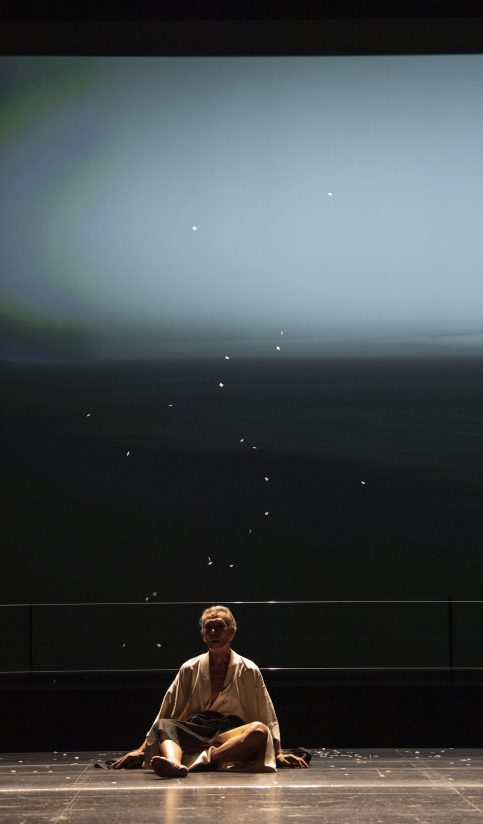
RYOKAN, The Minute Neighbor (starring theatrical dance-teller Min Tanaka)
Dates: December 16 (Fri) to December 18 (Sun), 2022
Venue: Tokyo Metropolitan Theatre Playhouse
Sponsors: Tokyo Metropolitan Foundation for History and Culture, Tokyo Metropolitan Theatre/Tokyo Metropolitan Government
Production associates: Madada Inc., Matsuoka & Associates
Planning and production: Tokyo Metropolitan Theatre



